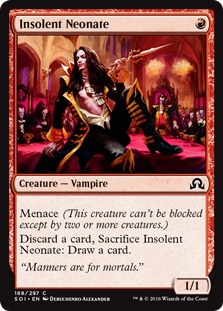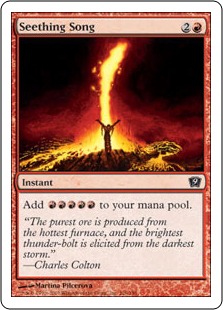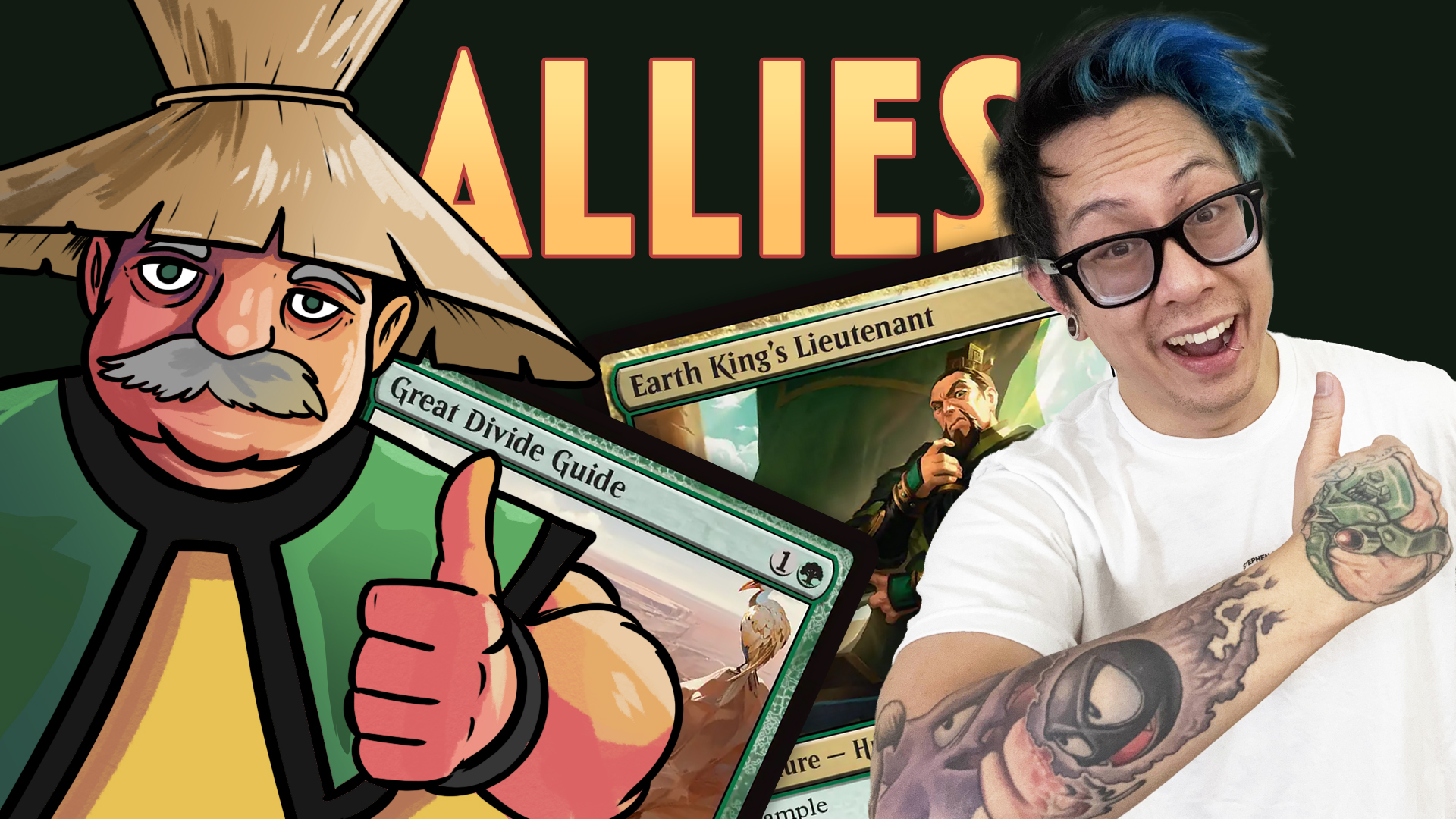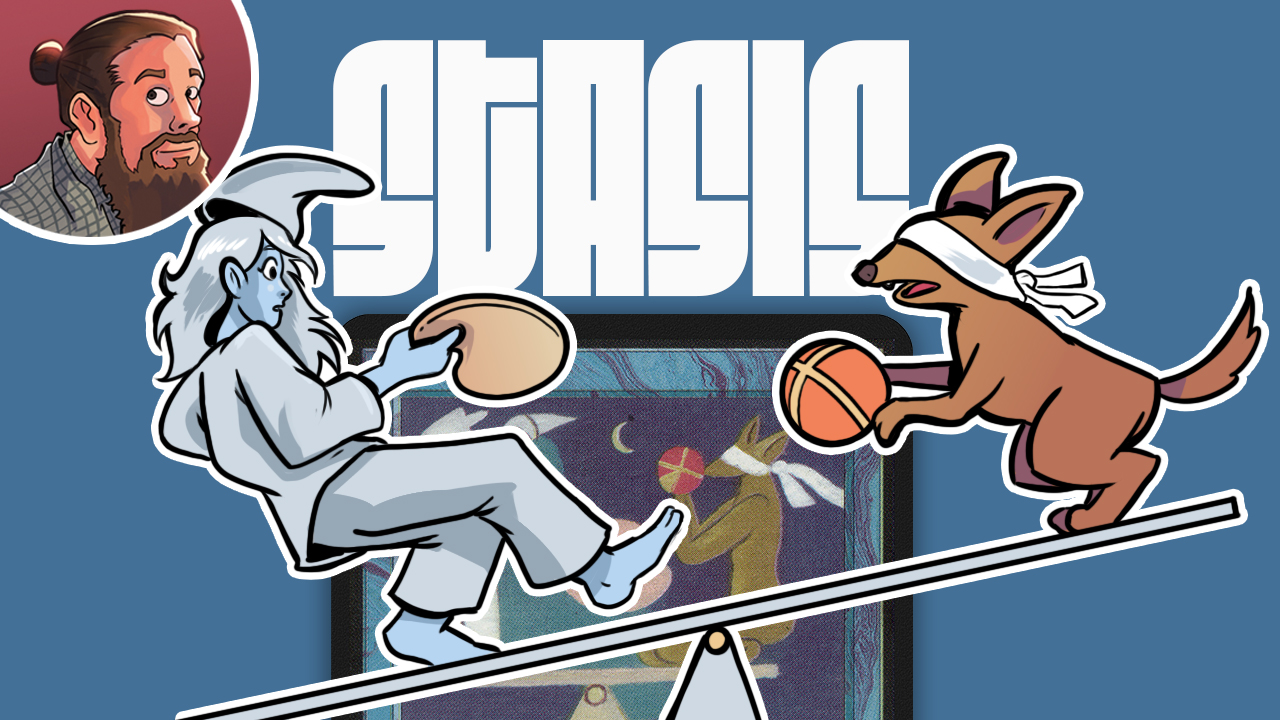Deck Evolutions: Modern Dredge
Dredge is all the rage in Modern. For the past few months, it has been firmly in the top tier of the format and at times has been the number-one overall deck in Modern. Even though the rise of Dredge as a true tier-one deck is relatively new, some form of Dredge deck has been floating around in Modern for years. So, today, we are going to take some time to look over the evolution of the deck, from the very first days of the Modern format up until now, where the deck is so good that some people are suggesting that it may need to be targeted with a banning. Also, since it's been a while since we've had a Deck Evolutions article, I figured it was worth highlighting some of the old articles, in case you missed them. Today's Dredge Deck Evolutions is actually the fifth installment; in the past, we've covered Modern Tron, Legacy Miracles, the now-extinct Modern Twin, and Modern Jund. Anyway, let's break down the evolution of Dredge in Modern!
Ravnica Standard—2007

The story of Dredge in Modern starts several years before Modern was even a format, in the original Ravnica Standard format. Wizards, in a move that is now widely considered to be a mistake, made "dredge"—the ability to get a card back from your graveyard by milling X number of cards instead of drawing a card—the mechanic of the Golgari guild. While deck lists from 2007 are spotty at best, Dredge was a big part of the Standard format, and while the support pieces were much, much different than they are today, the basic idea and the key cards remained the same.
The Standard version of Dredge looked to use discard outlets like Llanowar Mentor, Merfolk Looter, and Magus of the Bazaar to get dredgers like Golgari Grave-Troll, Stinkweed Imp, and Life from the Loam into the graveyard. It would then fill its graveyard at lightning speed with the help of the dredge mechanic, generate a bunch of Zombie tokens with Bridge from Below (sometimes with the help of a sacrifice outlet like Drowned Rusalka), and then finish the game by reanimating Akroma, Angel of Wrath or Flame-Kin Zealot by flashing back Dread Return. The key synergy here is Bridge from Below and Dread Return. Once you mill most of your library, it becomes super easy to reanimate a bunch of things for free because whenever you sacrifice creatures to flashback Dread Return, you get a bunch of Zombie tokens from your Bridge from Below, which in turn allows you to flashback even more copies of Dread Return until you win the game with one big combo-esque turn.
Extended Dredge—2008–2010

Major Additions: Bloodghast, Hedron Crab, Iona, Shield of Emeria.
Major Subtractions: Various "looters" like Merfolk Looter and Bonded Fetch.

Extended (which was replaced by Modern, in case you weren't playing back in 2011) Dredge played similarly to Standard Dredge—fill the graveyard, flashback Dread Return with several copies of Bridge from Below in the graveyard, and win the game—but with a couple of major additions from Zendikar block. First, the deck gained Hedron Crab, which made all of the random looters like Merfolk Looter from the Standard-legal build of the deck a thing of the past. The major challenge for a Dredge deck is getting the first dredge card in the graveyard as quickly as possible—the sooner you can do this, the sooner you can start milling your deck and setting up the combo kill. The Standard deck used Merfolk Looter and Magus of the Bazaar in this role, which could get between one and three cards in the graveyard on Turn 3. With the help of Hedron Crab, the extended version could get six cards in the graveyard (for no mana) on Turn 2 by simply playing and cracking a fetch land. As a result, the deck was not only faster but more consistent, thanks to the ability to get twice as many cards in the graveyard.

The second Zendikar addition to Extended Dredge was Bloodghast. While Bloodghast might not look like much, it's actually an amazingly powerful card in a Dredge build because it does everything a Dredge deck wants. In older formats like Legacy and Vintage, Dredge has cards like Ichorid and Nether Shadow to fill this role, but before Zendikar, this type of card was missing from the Extended (and later, Modern) card pool. In Extended Dredge, Bloodghast was a card that could be milled into the graveyard with dredge, come back from the graveyard for free with landfall, possibly do some attacking (dealing with four Bloodghasts can actually be super annoying because they just keep coming back), and in the late game make an amazing combo with Bridge from Below and Dread Return, generating a ton of Zombies when they are sacrificed and then returning to the battlefield for free.
The Birth of Modern—August 2011


I mentioned that now, with the benefit of hindsight, printing the dredge mechanic at all is widely considered a mistake, not just by players, but by Wizards itself. Well, when Modern came to be in 2011, Wizards decided to fix its mistake once and for all by banning both Golgari Grave-Troll and Dread Return preemptively, before the first Modern tournaments. Make no mistake about it: these bannings were designed to literally rip the heart out of Dredge and make the deck completely unplayable. While the deck could survive without Golgari Grave-Troll by playing other slightly less powerful dredgers, the loss of Dread Return took the deck's primary combo and game plan off the table. It looked like Dredge in Modern was dead before the format even began. Here's some of Wizards' explanation for the banning:
The last turn-three deck that remained was Dredge...Dredge is not known for being fun to have around. Although games against it are often interesting, the larger game of deciding whether to dedicate enough sideboard slots to defeat it or ignore it completely and hope not to play against it is one that is not very satisfying for most tournament players. We chose to ban the most explosive graveyard card rather than leave that subgame present.
Dredgevine—Fall 2012

Major Additions: Gravecrawler, Vengevine, Skaab Ruinator, Faithless Looting, Unburial Rites.
Major Subtractions: Bloodghast, banned cards, Bridge from Below, Ideas Unbound.
The biggest takeaway here is just how long it took for people to try the dredge mechanic in Modern after the bannings of Golgari Grave-Troll and Dread Return. Modern officially came to be in August 2011, and it wasn't until the fall of 2012 that we had our first results for Dredge in a Modern tournament—a gap of over a year. While this was partly because people simply assumed Dredge couldn't work without the banned cards (without Dread Return, the Bridge from Below combo doesn't work, and without the combo, traditional Dredge was off the table in Modern), it's also that the deck was simply lurking behind the scenes, waiting for the right pieces to be printed. Filling your graveyard at lightning speed always has potential to be broken, so it seemed obvious that, sooner or later, Wizards would print cards that would allow Dredge to rise again, and this finally happened with the renewed focus on graveyards in the original Innistrad block.

As far as Dredgevine itself, the most important piece of the deck is Vengevine, which much like Bloodghast is a creature that can return from the graveyard for free. Unlike Bloodghast, which has more value as a combo piece than a beater thanks to its relatively weak 2/1 body, Vengevine is huge as a 4/3 with haste. As such, there was once again a worthy payoff for filling your graveyard with dredge cards. This said, Vengevine was printed in Rise of the Eldrazi, all the way back in 2010, but no one was playing Dredgevine in Modern, so what happened in 2012 to push Dredgevine to the forefront of the format?


Vengevine is a unique card because to return from the graveyard, it actually requires two creatures to be cast in the same turn, which means traditional Dredge cards like Bloodghast and Narcomoeba (which enter the battlefield but are not cast) have no value when it comes to returning Vengevine from the graveyard to the battlefield. Then, in Innistrad, Wizards printed two cards that fit perfectly into the graveyard plan. First and most important was Gravecrawler, a card that is normally worse than Bloodghast (although very similar as a 2/1 that can't block) but a major upgrade with Vengevine because instead of returning for free, you cast it from the graveyard for a single mana (assuming you control a Zombie). Second was Skaab Ruinator, which gave the deck a way to get a Zombie onto the battlefield, which in turn allowed it to cast its Gravecrawlers from the graveyard.
As a result, rather than flashing back a Dread Return and triggering Bridge from Below, the new Dredgevine build attempted to fill the graveyard with Vengevines, cast a couple of Gravecrawlers or Skaab Ruinators in the same turn, and then return a bunch of hasty Vengevines to the battlefield and hopefully kill the opponent with a big hit of surprise damage. Unfortunately, for lovers of the dredge mechanic, Dredgevine was never quite good enough; while it put up a handful of low-level results over the next couple of years (winning a few daily events on Magic Online and posting a couple of PTQ Top 8s), it never put up a marquee finish, and even the low-level results were few and far between (I count a total of 18 low-level finishes between 2012 and the beginning of 2015). Dredge was technically part of the format, but it certainly wasn't anything to be scared of—at least, not yet.
Golgari Grave-Troll Unbanned—February 2015
While there had been rumblings for a while from some pros that perhaps Golgari Grave-Troll was safe to come off the Modern banned list (technically, all it does is dredge a couple extra cards, compared to the other options, because it is almost never cast), but most of the community was surprised when Wizards announced that Golgari Grave-Troll was coming off the Modern banned list in February 2015. The official reason for the unbanning was essentially, "Dredge in Modern is horrible, and while unbanning Golgari Grave-Troll might give some of you some unpleasant flashbacks to broken things in the past, it should be fine today."
While this might sound strange now, considering Dredge is currently one of the very best decks in Modern (and some people are arguing for a banning), the data show that Wizards was 100% correct about Golgari-Grave Troll. During all of 2015, Golgari Grave-Troll showed up in a grand total of four winning deck lists (all of them Dredgevine), and its best performance was going 5-0 in a Magic Online daily event. While it might be counterintuitive, Dredgevine actually got worse with the release of Golgari Grave-Troll, posting fewer results than it did in the previous years while Golgari Grave-Troll was banned (possibly because players were scared of Golgari Grave-Troll and made sure to pack graveyard hate). Then, in 2016, everything changed. When historians look back on this time decades in the future, at least as far as Magic is concerned, it will be known as the year that Wizards broke Dredge in Modern.
Zombie Infestation Dredge—March 2016

Main Addition: Conflagrate, Zombie Infestation, Squee, Goblin Nabob.
Main Subtractions: All the Vengevine stuff (Gravecrawler, Skaab Ruinator, Hedron Crab, et al.).
The easiest thing to do would be to write off Zombie Infestation Dredge as a novelty; in fact, I almost didn't include this evolution on our list. The idea of using Zombie Infestation to generate a bunch of 2/2 Zombie tokens with Squee, Goblin Nabob was short lived. It managed to Top 8 GP Melbourne in March, in the hands of Jason Chung, as a rogue brew designed to fight against the Eldrazi menace (the Top 8 of GP Melbourne was incredibly weird, featuring Zombie Infestation Dredge, three copies of Eldrazi, and three copies of Living End to go with one Chord of Calling deck); then, it was played for a couple of weeks on Magic Online and then quickly faded from the scene. While most of Zombie Infestation Dredge was quickly forgotten (especially the namesake Zombie Infestation), the brew did lead to one massive, huge, lasting innovation.


As far as I can tell, Zombie Infestation Dredge is the first dredge build in Modern to really focus on the combo of Conflagrate and Life from the Loam. While certainly not as powerful, you can make an argument that Conflagrate is essentially the second coming of Dread Return—a flashback spell that ends games for an extremely low price after being dredged into the graveyard.
If you look at the Dredge decks that we've talked about so far, they all have one thing in common: they only have one plan, which is to beat down with creatures. Sure, they can get back Vengevines, Bloodghasts, and Gravecrawlers for free (or very cheaply), but if the opponent has a way to disrupt their creatures (and it can be as simple as several copies of Path to Exile backed by blockers), the plan of these decks suddenly fizzles. Adding the engine of Life from the Loam and Conflagrate gives Dredge a way to win with direct damage with just one or two big Conflagrates. Now, instead of needing to deal 20 damage with Bloodghast and friends, Dredge can focus on dealing 10 damage, knowing they can always flashback a huge Conflagrate to finish the game. So, while most of the interesting aspects of Zombie Infestation Dredge proved to be not quite good enough, the short-lived brew can claim a lasting impact on Modern Dredge thanks to its addition of the flashback burn spell.
Insolent Dredge—May 2016

Major Additions: Insolent Neonate, Prized Amalgam.
Major Subtractions: Zombie Infestation, Squee, Goblin Nabob.
The month of May in relationship to the development of Modern Dredge was simply amazing. With the help of daily deck lists from Magic Online and other tournaments, we can see the evolution of the deck on an almost daily basis over a period of about four weeks. Let's start by talking about the cards that facilitated these evolutions, and then we'll take a look at just how quickly a deck can change as players are trying to figure out the optimal build.


Almost immediately, everyone realized that Insolent Neonate and Prized Amalgam had the potential to do some crazy things in Dredge. While Insolent Neonate may not seem all that broken, when you look at it in the context of the history of Dredge, you can see the power of the 1/1. The key thing here is that Insolent Neonate allows a player to discard before drawing, which means that you can discard a card with dredge and then, instead of drawing the card, immediately start dredging.
Back in the earliest build of Dredge, players were using cards like Magus of the Bazaar, which could theoretically get three cards into the graveyard on Turn 3, with the backup being Merfolk Looter, which only put a single card in the graveyard on Turn 3. Later builds used Hedron Crab, which could mill six cards on Turn 2 with the help of a fetch land, or Faithless Looting, which could get two cards in the graveyard on Turn 1. While Hedron Crab and Faithless Looting were certainly an upgrade compared to Magus of the Bazaar and friends, they are nothing compared to Insolent Neonate. When you discard a Golgari Grave-Troll or Stinkweed Imp to an Insolent Neonate, you are essentially milling five or six cards on the very first turn of the game!
Meanwhile, Prized Amalgam gave Dredge not only another free creature to return from the graveyard but also a really powerful creature. Instead of being a 2/1 that can't block like Bloodghast or a 1/1 like Narcomoeba, Prized Amalgam is a 3/3—almost the same stats as a Vengevine but without all the deck-building restrictions that come with needing to cast two creature spells in the same turn. More importantly, the addition of Prized Amalgam gave Dredge a critical mass of free creatures, making it much closer to the Legacy and Modern versions of the deck. Apart from one- and two-mana card draw / discard spells, with the addition of Prized Amalgam, it's completely possible for Dredge to win games without ever casting anything, just like in Legacy and Vintage.
As I mentioned a couple minutes ago, the evolution of Modern Dredge was fast and furious through the month of May, so let's take a minute to look at these developments in real time.
April 25: A Magic Online player named Legion273 posted the first finish with a Modern Dredge deck featuring Insolent Neonate and Prized Amalgam, essentially jamming the cards into the old Dredgevine deck.
May 5: RandomDrooler 5-0ed a Modern League with a version of the Dredgevine deck that was focused on dredging as much as possible as quickly as possible, adding in cards like Burning Inquiry and Goblin Lore to dredge four or five times as early as Turn 2.
May 8: Manoah 5-0ed a league with a deck list that looked very much like the RandomDrooler list but showed the influence of the Zombie Infestation Dredge deck, adding a single copy of Conflagrate.
May 9–May 24: Several players posted finishes with some mixture of the above lists. Players slowly began to move away from Vengevine, instead running more and more card draw to dredge multiple times a turn. However, even as Vengevine slowly left the build, the focus was still solely on beating down with creatures.
May 25: We saw the addition of Shriekhorn in an Insolent Dredge deck on Magic Online as another way to get cards into the graveyard on Turn 1.
May 30: A Magic Online player named kangurello played a Vengevine-less build of Insolent Dredge (shown above) that went all in on the Conflagrate / Life from the Loam backup plan, playing four copies of each. With this evolution, the devastating, fast, and efficient build of Modern Dredge that we see today was born. In fact, the list that kangurello played on May 30 is only three cards off (discounting a new card that we'll talk about next) from the most recent Modern Dredge list in the MTGGoldfish database. The changes? Kangurello was playing Stitchwing Skaab, while the most recent build plays one Shriekhorn and one Rally the Peasants in its place.
Cathartic Dredge—October 2016

Major Addition: Cathartic Reunion.
Major Subtraction: Tormenting Voice (or whatever random card draw was in this slot).

Much like Insolent Neonate, Cathartic Reunion doesn't look like a broken card. Actually, apart from specific, synergistic decks, it's not even a playable card. However, with the printing of Cathartic Reunion in Kaladesh, Wizards pushed Dredge, which spent the summer floating in the tier-1.5 range, to the very top of the Modern format. Cathartic Reunion is the card that makes Dredge into a deck that, with a reasonable draw, can untap on Turn 3 with 15+ power worth of creatures on the battlefield. Let's look back at the numbers one more time.
Ravnica Standard Dredge: Three cards in the graveyard on Turn 3 (thanks to Magus of the Bazaar).
Extended Dredge: Six cards in the graveyard on Turn 2 (thanks to Hedron Crab plus a fetch land).
Insolent Dredge: Six cards in the graveyard on Turn 1 (thanks to Insolent Neonate plus a dredger).
Cathartic Dredge: 24 cards in the graveyard on Turn 2 (thanks to Turn 1 Insolent Neonate plus a dredger, dredge instead of drawing on Turn 2 into Cathartic Reunion, dredging twice more).
With the addition of Cathartic Reunion, Dredge not only has the devastating Plan B of Conflagrate and a bunch of free creatures but also a legitimate nut draw where the deck simply casts a Cathartic Reunion on Turn 2; dredges into two, three, or four copies of Prized Amalgam along with a Narcomoeba (or, in the worst case, Bloodghast); and gets somewhere between four and eight creatures back from the graveyard for zero mana. At this point, targeted removal is off the table, and even a Wrath of God doesn't do much because all of the creatures will just come back again, thanks to Bloodghast), so barring something like Anger of the Gods or Ensnaring Bridge, it's almost impossible for the Dredge deck to lose, especially when you consider they really only need to get in one attack to be able to finish the game with Conflagrate and Life from the Loam.
The Future of Modern Dredge
Now for the most important question: what does the future hold for Dredge in Modern? While I hate to say it, I fully expect that, sooner or later, the deck will be targeted by a banning. If we look back on the original Modern announcement one more time, many of the reasons the deck was banned in the first place seem to apply to the most recent builds of Dredge.
- The last turn-three deck that remained was Dredge. This is little doubt that Dredge, in its current form, is a Turn 3 deck, and a very consistent one at that. If being a consistent Turn 3 deck is still a reason for a deck to be targeted by a ban, it seems like Dredge should be on the short list. The question is whether the Turn 3 rule still applies, and the answer very well may be no.
- On top of this, Dredge is not known for being fun to have around. Dredge hasn't magically become more fun over the past few years.
- Although games against it are often interesting, the larger game of deciding whether to dedicate enough sideboard slots to defeat it or ignore it completely and hope not to play against it is one that is not very satisfying for most tournament players. This paradigm remains, and with Dredge being a tier-one deck, warping your sideboard to have a chance against the deck is more important now than ever. One of the big problems with interactive midrange and control decks in Modern is that it's next to impossible to pack enough cards in your deck to compete with all of the goldfish decks, because while all of these decks can kill on Turn 3, they do so in very different ways. Dredge is beatable if you pack at least four graveyard-disruption cards in your sideboard, just like Affinity is beatable if you have a bunch of artifact hate, Tron if you have Fulminator Mage, Infect if you have Sudden Shock and Gut Shot, and Death's Shadow Zoo / Burn if you have Chalice of the Void. The problem is there simply are not enough slots to go around, so by building your deck to beat Dredge, you lose to another Turn 3 goldfish deck.




While Wizards doesn't mention this specifically in the banning announcement, I think the fact that Dredge is widely considered a massive mistake makes a banning more likely as well. In the history of Modern, most bans have been targeted at decks that are at or near the top of the metagame when the banning occurs, but there is one major exception in Storm. Storm—another "mistake" mechanic—was continually targeted by bannings even after the deck was essentially unplayable, and the only reason that makes sense is that Wizards simply wants to wipe the memory of the mechanic out of existence. I could imagine the same thing happening with Dredge.


The bigger problem is that there's no middle ground with Dredge. It's either completely unplayable or completely broken. As a result, I'm not sure there is a way to ban Dredge into being just another good deck, let alone a fair deck. If you re-ban Golgari Grave-Troll, the deck simply slots in Golgari Thug, and while the deck is slightly weaker since it will dredge fewer cards on average, there's a good chance that, with the amount of support the archetype has, Dredge would still remain one of the best decks in the format. On the other hand, if you ban both Stinkweed Imp and Golgari Grave-Troll, the deck will likely be completely unplayable. So, unlike Eldrazi, where getting rid of Eye of Ugin turned the deck from an oppressive monster into just another tier-one deck, I'm not sure this is possible with Dredge.



One thing I know for sure is that we should not be banning symptoms. I've heard some suggestions that we should ban cards like Bloodghast, Prized Amalgam, and Cathartic Reunion, and while it's true that these support cards are what make the current build of Dredge so powerful, there's a massive problem with this plan: we want Wizards to be able to print Bloodghasts, Prized Amalgams, and Cathartic Reunions. If we ban these cards and let the dredge engine survive, we are committing to banning the next Bloodghast, the Bloodghast after that, and the one after that—either that, or Wizards will simply have to stop printing powerful, graveyard-based cards out of fear of making Dredge too powerful. In the words of Jeffery Lewis, "if you shoot the head, you kill the ghoul," and this is very true of Dredge. There are only two options: do nothing and be overrun by the undead menace, or shoot the head of the ghoul by banning Golgari Grave-Troll along with Stinkweed Imp to put the deck down once and for all.
Conclusion
Anyway, that's all for today. What do you think? Does Dredge deserve to be targeted with a banning? If so, what should be banned? Also, is there a way to ban Dredge into being "just another good deck," or is banning it from existence the only option? Let me know in the comments. As always, you can reach me on Twitter @SaffronOlive or at SaffronOlive@MTGGoldfish.com.













